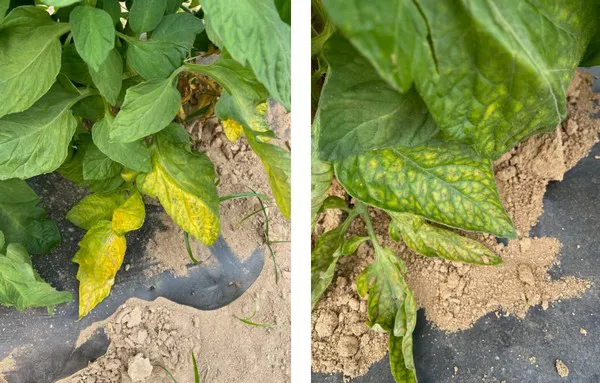How can growers prevent nutrient deficiencies in crops? Soil testing and tissue testing for fertility management of vegetable crops is key to having the correct levels of nutrients to have a high yielding, high quality crop to harvest and market. Soil testing is best done in fall so that pH levels can be adjusted with soil amendments like lime that correct pH levels for maximum return on fertilizer uptake. Why adjust pH to proper levels? Plant nutrients are hindered in availability when soil pH is either too high to too low. Besides pH, fertility levels are important to monitor and adjust pre-plant for the best start to new seedlings and transplants.

With tomato production it is widely known that calcium (Ca) levels in soil are important for prevention of blossom end rot. Therefore, tomato growers have focused on application of adequate and even high levels of calcium to prevent this fruit disorder. In addition, it is important to also pay attention to magnesium (Mg) levels. Ca and Mg are both important in tomato production and even though blossom end rot can cause tomato fruit to be unmarketable, Mg deficiency can reduce overall plant health and ultimately quality and yield. Magnesium in tomato plants plays an essential role in photosynthesis (the process of the plant to make energy to fuel growth), protein synthesis (necessary in cell formation), activation of plant enzymes (necessary for many cellular and growth functions), and chlorophyll synthesis (the green pigment in plants that is essential for optimum plant growth).
Magnesium deficiency can occur, especially in sandy soils, when soil is overwatered or after heavy rainfall events. However, when Ca and Mg levels are out of balance, deficiencies can still occur even when both are showing adequate levels in the soil. It is more important to look at the actual levels. If one is significantly higher than the other deficiency symptoms may occur. Since both Ca and Mg are +2 ions in soil when taken up by plant roots, the plant indiscriminately takes up these two nutrients. Therefore, if there is abundant Ca and lower Mg, Mg deficiencies may be seen. Conversely, when Mg levels are higher than Ca levels blossom end rot may be seen. It is best to have these two nutrients in soil at the same levels to keep a balance in uptake and ultimately promote both healthy fruit formation and foliage growth. Allowing Mg levels to remain deficient in the plant will result in lower yields and less energy for fruit production later in the plants lifecycle.
Magnesium deficiency is first seen on tomato plants as interveinal chlorosis – yellowing of leaf tissue between the veins of older leaves. Eventually the leaves become mostly yellow and purplish-red spots that become necrotic on the interveinal tissue may occur. See photos taken in the field on June 7, 2023.
Deficiency symptoms can be seen at any stage of growth, but are generally first seen when plants begin to flower, start fruit set, and fruit enlargement. When plants change from vegetative growth (production of leaves and stems) to reproductive growth (flowering and fruiting) leaves are stressed and energy and resources are reallocated into growth and development of new progeny (seed and fruit).
Fortunately, Mg deficiency is easily corrected when caught early in the tomato plant’s growth by the application of Epsom salts. Rates differ depending on soil type, soil levels, and plant tissue levels. Mg rates can vary from 5-25 pounds per acre. Application can be done through drip irrigation systems or applied on the soil surface by spraying near the rootzone. When applying through the drip tape, be sure to run the lines with clean water for at least 20 minutes after the salts have gone thorough to prevent salt build up in the emitters. Foliar applications of Mg can be sprayed on plants, but are not as efficient as soil application and root absorption. There are other products available to correct low levels of Mg, but most data available for the use of Epsom salts to raise Mg levels. Pre-plant, the use of high Mg liming products can balance Ca and Mg levels in soil if Mg levels are lower than Ca levels. Therefore, when lime is needed to raise pH it is very important to look at Ca and Mg levels on the soil test results before selecting which type of lime will work best for adjusting the levels of these two very important plant nutrients.
When managing fertility levels for successful crop production, it is important to know the levels of plant nutrients in soil and tissue tests. It is as important to understand the interactions between plant nutrients and how they affect plant growth. Seeing an “optimum” or “sufficient” level on a soil or tissue test report is not enough to fully determine what is needed for high yielding, high quality crops.
Source: plant-pest-advisory.rutgers.edu
